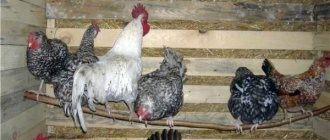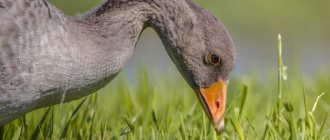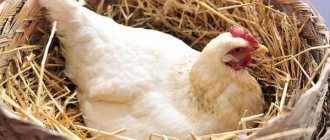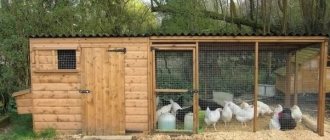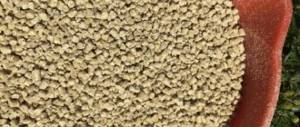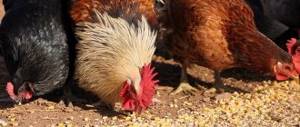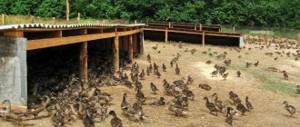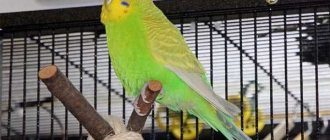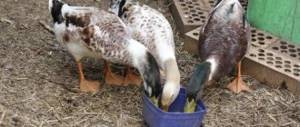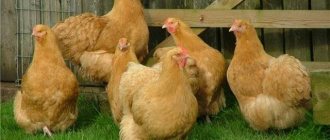Main types of feeders
Feeders for turkeys come in three types, which are simple to set up and easy to use:
- Solid feeding area. It is a one-piece container and allows birds to feed from one section at a time;
- Sectional area. This is a container divided by vertical partitions into several compartments into which various types of feed can be poured;
- Box feeder. This is a bunker-type device with a pitched roof. A mesh is often used as a base.
The first two options can be in the form of wooden feeders and are suitable for pouring dry food and mineral supplements.
An example of the implementation of a wooden feeder.
You can also place shells or small gravel in fractional form in separate sections. The third can be used to fill with greens, which turkeys can reach through the mesh. These types can be manual or automated.
The most optimal and common type is a simple but convenient feeder for constant feeding. If the house is spacious enough, it is recommended to install it in such a way as to provide access from all sides. When using bunker models, the installation location is selected in such a way that nothing interferes with periodic cleaning and cleaning of the container. The height of the feeders is placed 20-25 cm from the floor, and filling with food should not exceed a third of the total volume of the section. This will prevent birds from scattering food.
Ready-made feeders
You can buy ready-made feeders and drinkers for turkeys - different designs are available. When choosing them, you need to be guided by the following factors:
- the presence of elements (bars, mesh, turntables, sides) that prevent birds from scattering feed;
- ease of use (filling with food, cleaning);
- convenience for the bird;
- size, stability and strength;
- non-toxic material.
You can make a turkey feeder with your own hands using available materials - most often the material is plastic pipes. Working with plastic is not difficult, but it is important to pay attention to safety - if there are sharp edges, they must be cleaned to avoid the possibility of injury.
- Related Posts
- How many eggs does a turkey lay?
- Turkeys Hybrid Converter
- When do turkeys start laying eggs?
- How to pluck a turkey?
- Victoria turkeys
- How long do turkeys live?
Simple homemade drinking bowls
Turkeys drink a lot of water. During the day, they can drink two or three times more liquid than food. Therefore, farmers must provide the brood with sufficient water. The abundance of fluid has a positive effect on the health of the farm - it gets sick less often, in addition, the quality of its meat improves.
Homemade automatic bird drinker
Drinkers for turkey poults aged 1–2 weeks must be of the nipple type. Only after three weeks can you switch to watering from vacuum or drip models.
The nipple drinker is a convenient design that is actively used on modern farms. Their work is based on the supply of water from the container through nipples. This design protects the farm from unnecessary waste of water and prevents young animals from choking. Water is supplied through the nipple.
The simplest design is a bottle drinker for domestic turkeys. You can make it yourself from scrap materials - a deep nylon cap and a plastic bottle. It is worth noting that a glass jar is also suitable for this type of drinker.
Scheme for making a bottle drinker
Heat a knife or awl and make a small hole in the neck of a plastic bottle at a height of 2 cm. Place a large cap on the neck. The bottle is filled with water and turned upside down. In this position, water will begin to flow into the lid, filling it to the brim. The design works on the principle of vacuum drinkers.
The simple design has its advantages and disadvantages. Among the strengths, it is necessary to highlight the ease of assembly and the minimum list of required materials. However, a homemade bottle drinker is not stable. At home, adult turkeys often overturn a fragile structure, depriving them of a source of water.
You can increase the stability of the model with your own hands without resorting to complex technological solutions. The turkey drinker can be attached to a vertical support at a height of 20–30 centimeters for poults and 40–50 centimeters for adults.
Drinker made of plastic pipes.
Sewer pipe as a drinking bowl
The advantages of this device: easy to make, suitable for turkeys of different ages.
Minimum list of materials for manufacturing:
- Bulgarian;
- Two plugs for a plastic pipe with a diameter of 110 mm;
- Plastic pipe 1.1–1.5 m long and 110 mm in diameter;
- Tee-separator for pipe.
The pipe is cut into three parts, 20, 20, 70 cm each. Twenty-centimeter pipes are connecting pipes, so they are closed from below with plugs. A tee is installed on top of the connecting pipe.
A long pipe is connected to a tee and secured to a vertical base with wire. In short pipes the top is cut off. It is worth noting that it is better not to cut short pipes along their entire length, otherwise you will not be able to connect them to the tee with your own hands.
Features of a homemade turkey feeder
A homemade feeder for turkeys and chickens has certain advantages over a store-bought product:
- Ease of manufacture. Drawings for many types of feeders are publicly available. In addition, there are photos and videos of various master classes.
- Individual parameters. Homemade feeders are easy to use, since the size of a particular poultry house will be taken into account when creating them.
- Minimum material costs. Usually, to create such devices, I use materials that are always at hand - boards, bottles, buckets.
We make feeders for turkeys ourselves
You can make trays yourself! The manufacturing process is simpler than it might seem at first glance. Let's look at the most popular options that are made on farmsteads.
Plastic feeding box
To make such a container for food, it is enough to stock up on a plastic pipe at least a meter long. You can buy it at any plumbing store. The diameter of the pipe should be about ten centimeters. You will also need several plugs, a file for cutting the pipe, and a tee that fits the size of the pipe.
So, it is necessary to cut the pipe into three parts of different lengths. The first part is ten cm, the second is twenty cm, the third is 70 cm. Round holes should be cut out on the first two parts of the pipe. Through them, birds will gain access to food.
The seventy centimeter segment remains unchanged. We take a piece of twenty centimeters - we supply one end with a plug, and the other with a tee. Now we take a short piece and attach it to the tee, getting a T-shaped structure.
Place the remaining plug on the pipe. We attach the feeder vertically. To prevent debris from getting into the pipe, it is better to close the holes during feeding breaks.
Plastic bottle feeder
The universal tray is suitable for both adults and chicks. To get started, just take a plastic water bottle. The desired volume should be five liters.
A board or plywood is suitable as a base. File for cutting bottles and sawing plywood. You also need a hammer, a screwdriver, screws, and bolts. Insulating tape will be useful for holding the parts together.
First, he cuts off the bottom of a plastic bottle. Birds will eat grain and cereal mixtures from it. The height of the side part should correspond to the size of the bird. For young birds, low sides are made; for older birds, the edges are raised by 20-25 centimeters.
From the second part you need to cut off a structure like a scoop for grain cereals. Next, use electrical tape and self-tapping screws to attach the resulting parts to the plywood board. The feeder is ready and can be installed in the poultry house. To make the structure as stable as possible and not be overturned by birds, it should be strengthened with a rope to a vertical surface.
Wooden tray
Wood products are much less susceptible to wear and tear than plastic. You can put together a food box from boards or plywood. Care should be taken with nails and screws. They must not injure the bird. It is better to pour grain and feed into the box from an improvised funnel. Such a structure should be wide at the top and narrow towards the bottom. The funnel is attached to the walls of the feeder.
Feeders that are easy to make yourself
Due to the fact that making a turkey feeder with your own hands is not difficult, you can avoid unnecessary financial costs when arranging a poultry house.
Feeder made from plumbing plastic pipes
One of the easiest to make. Its advantages are that the food does not scatter on the floor, as well as ease of cleaning. Designed for 10 birds.
Materials:
- plastic plumbing pipe with a diameter of at least 100 mm and a length of at least a meter;
- plugs suitable for the pipe size – 2 pcs.;
- a tool suitable for cutting plastic;
- tee suitable for the pipe size.
Manufacturing principle:
- The plastic pipe must be cut into 3 parts: one should be 10 centimeters long, the second should be 20 cm long, and the third should be 70 cm long.
- Leave the longest segment unchanged, and cut round holes on the other two: through them the turkeys will get the food in the pipe.
- Install a plug on one end of a 20-centimeter pipe, and a tee on the other.
- The shortest section must be attached to the tee so that it appears to be a continuation of the 20-centimeter length.
- Attach the remaining section of pipe to the last entrance of the tee, and place a second plug on the end of it. It should be a T-shaped design.
- The structure is attached to any vertical surface with the longest part so that the pipes with holes are 15 cm from the floor. You need to make sure that the holes face the ceiling.
How it looks, look at the photo
Advice! To prevent debris from getting inside, it is better to close the openings at night.
Instead of several round holes, you can cut one long one.
Hopper bottle feeder
Suitable for turkey poults or as a feeder for each bird.
Materials:
- plastic water bottle with a volume of 5 liters or more;
- board or plywood for the base of the feeder;
- a hacksaw or other tool that allows you to cut plastic;
- hammer or screwdriver;
- rope;
- electrical tape (fastening or plumbing);
- mounting angles;
- materials for fastening (screws, nails, etc.);
- plastic pipes (one with a diameter of 30 cm, the second of such a diameter that the neck of the bottle fits into it).
Manufacturing principle:
- Cut a piece from the largest diameter plastic pipe - turkeys will peck food from it. The piece should be of such a height that it is convenient for turkeys to eat (lower for babies, higher for adults).
- Cut a piece from the second pipe, twice as long as the first. This piece needs to be sawn lengthwise, starting from one edge and not reaching the middle by about 10 cm. One sawn part is cut off completely. It looks like a scoop for bulk cereals.
- Attach a plastic plumbing pipe with a diameter of 30 cm to the base board using corners and self-tapping screws so that it faces upward. The mounting angles must be inside the pipe. You need to attach it so that the nails or screws do not stick out, otherwise the turkeys may get hurt by them.
- Remove the bottom of a plastic bottle. Insert the neck of the bottle into a pipe of smaller diameter (on the side from which it was not cut). The place where the neck comes into contact with the pipe should be wrapped with electrical tape.
- Attach the opposite (cut) part of the pipe from the inside to the wide pipe so that the end rests against the base board. How to make a feeder, watch the video:
- The structure is ready. Now it needs to be installed in the poultry house. To give the structure greater stability, you should attach it to a vertical surface with a rope tied to the top of the bottle.
All that remains is to test the design by pouring food into the bottle and inviting the turkeys “to the table.”
Wooden bunker feeder
This design is more stable than a feeder, for example, made of plastic. The easiest way is to put together a container from boards or plywood, from which the turkeys will eat, and a “hopper” into which the food will be poured. The “bunker” should be wider at the top and narrower at the bottom, like a funnel. The “hopper” is then attached to the walls of the feeder. The structure itself is either made on legs or attached to the vertical surface of the poultry house.
See the photos for an example:
General requirements for turkey feeders
Today we will look at the most affordable options, for the creation of which you can use available tools. But first, it’s worth knowing the key points that you need to pay attention to when creating a feed container:
- the design should allow the birds to freely and without difficulty get food, so the container should not be higher than 15 cm;
- In order to prevent food from scattering, it is necessary to attach the container to the floor. You should also fill the container to 1/3 of its volume;
- structural elements must be treated with an antiseptic before you place food inside;
- it is necessary to accurately calculate the number of containers for the number of birds so that turkeys do not show aggression and do not push around the feeders;
- It is recommended to use different containers for different types of feed to ensure balanced nutrition for turkey poults.
Types of feeders for turkeys
Three types of feeders are recommended for turkeys:
- a platform divided into sections,
- continuous feeding area.
- a box feeder with mesh walls and a sloping roof. It is suitable for fresh greens that birds can reach through the mesh.
The first types of feeders are used for mineral feeding.
The second type of feeders may have a hopper device, and they are also often automated for convenience. The compartments can be filled with lime, shell, and fine gravel.
The main and most popular type of feeder is simple containers for daily food.
If there is enough space in the house, place a long feeder, providing access to it from either side. Bunker models must be placed so that there are no difficulties in cleaning and disinfecting containers.
The height of turkey feeders should be about 15-20 cm, and fill them by a third so that the birds do not scatter the food.
Universal feeder for young animals
For turkeys and chickens, feeders are often built from scrap materials.
Since they need much less grain than adults, experienced poultry farmers use a special design. To build such a feeder, you need:
- A seven or ten liter bucket.
- Bowl with sections that are used for dogs and cats.
- Cutting tools.
The bottom of the bucket is attached to the bowl using self-tapping screws. On a kind of bunker, small holes are made according to the number of sections. The grain is poured into an open bucket, after which the lid is firmly secured. Under its own weight, the feed ends up in the trays. Thanks to the sides and a small amount of grain, turkeys and chickens practically do not scoop out food. Sometimes the feeder is attached to a vertical surface a few centimeters from the ground. In this case, you should cut off the excess sections of the base. In this situation, the young animals are unable to introduce dirt into the food, and the grain itself does not become soggy so quickly.
A sealed plastic bucket protects the grain from moisture. However, several small holes should be made under the lid itself, otherwise the food may suffocate. This method is rarely used for feeding adult turkeys or chickens, since the feeder is not very large. Older individuals are given vitamin supplements using such facilities. In some cases, the bucket can be replaced with a plastic bottle.
Automatic views
The main difference between automatic drinkers and conventional ones is that water is added to the drinking container itself from the reservoir as it is consumed. Such structures do not require constant monitoring and can be left for a long period of time.
The main disadvantage of automatic factory drinkers is the strict requirements for water quality. Any mechanical particles can damage the valve and block the operation of the device.
Automatic cup drinker P-4
This design is used in large farms where birds are bred as a business, but can also be used in home turkey poultry. The design consists of a plastic bowl with a diameter of 24 cm, which is fixed to a vertical water pipe through a connecting pipe, a locking rod with a valve and two springs. When the water in the bowl decreases, the lower spring lifts the rod up. He opens the valve and the bowl fills with water. As the container fills, it becomes heavier and, falling down, pulls the rod along with it and blocks the flow of water. The process is constantly repeated. On one water main, you can make several branches and install any number of drinking cups.
Grooved AP-2
This system consists of a trough that is automatically filled with water through a float valve. The gutter is mounted horizontally at the required height. The system maintains a constant water level in the gutter. The device is designed for a large number of birds. The disadvantage of the design is that water can spill out of the gutter, which increases its consumption and worsens the sanitary condition of the turkey poultry. Poor water quality can cause the valve to become clogged.
Vacuum
A vacuum drinker is a plastic container filled with water, which is located in a special tray where the water flows. Water is poured into a 5-10 liter container, the wide neck is covered with a tray with sides, then the entire structure is turned over. The vacuum keeps the liquid at the same level and prevents it from overflowing. The design itself is very simple and can be made independently. Vacuum drinkers are usually used for small turkeys. The design is convenient, but very unstable and adults can easily turn it over.
Round bell type
The operating principle of a bell drinker is similar to a cup design. Here, the operation of the valve is also controlled by the container filled with water. When the water runs out, the container rises under the action of a spring and opens the water supply valve. The design uses a bell-shaped reservoir, along the outer wall of which water flows to fill the tray. The device is quite complex and is not suitable for self-production.
Requirements for installing drinkers
The main requirement during installation is to prevent the bird from getting wet. Wet turkeys at any age can catch a cold, and a cold is a dangerous disease for them, often ending in death.
A turkey bottle should keep the water fresh and clean.
The following rules apply:
- Watering systems with cup drinkers are used for feeding turkeys from 15 days of age. Until this age, vacuum drinking bowls are used.
- The turkey run must be equipped with drinking bowls.
- Cup or nipple type drinkers are installed at the level of the turkey's head.
- Drinkers connected to an automatic drinking system are used to administer vitamins, dietary supplements and medications.
- Cup-type systems are the most hygienic, since water does not stagnate in them.
Not everyone who raises a bird has the opportunity to be near it all the time. Many live in cities and visit their poultry houses only on weekends. This is where complex structures come in handy - drinking bowls, from which the bird drinks as much fresh water as it wants and at the same time the litter remains dry and clean.
General requirements for installing drinkers for turkeys
First and foremost, turkey drinkers should be easy for the birds to use. They need to be located so that turkeys have unhindered access to water around the clock.
The liquid must be clean. To do this, the structure is installed at the height of the turkey’s back. The water must be changed periodically to ensure it is always fresh. Containers should be easy to clean and disinfect.
Turkeys are large and strong birds, so durable drinkers should be installed. These birds are also individualists. The ideal option would be to organize a watering hole in such a way that each bird uses its own drinking bowl. Otherwise, fights are possible, even to the point of seriously injuring each other.
There should be different sized structures for turkey poults and adult birds.
It is important to choose a drinking bowl so that turkeys cannot splash or spill water from the tank, otherwise there is a risk that the birds will get wet and get cold
When it's hot, turkeys may turn over their waterers to cool off. To avoid this, you can install containers with water for bird bathing in the summer.
To prevent this from happening, you should put a wooden circle in the water, in which you first need to cut several holes (3-4 pieces). Turkeys will drink water through them. The wood will float on the surface and prevent the water from freezing.
For newborn turkey poults, it is better not to install nipple drinkers, because the babies will have to make additional efforts to drink from them.
You can buy a structure for a watering hole or make it yourself. Each type has its own pros and cons, so before purchasing or designing, you should carefully consider and weigh everything.
Tips for the master before starting work
When making a turkey feeder, remember that all materials and accessories should be washed thoroughly. Ideally, they are disinfected with special liquids. Feeding devices are divided into the following groups, depending on the content:
To make the eating area complete, you can install bird drinkers. But most place it outside because turkey poults love to roam outside. During the first month, carefully monitor the feeders and drinkers, because the birds are actively emptying them. By building equipment for feeding turkeys with their own hands, poultry farmers reduce the required financial costs for arranging the premises.
Drinkers for turkey poults can be placed outside
Wooden feeder
Wooden structures are considered durable, capable of serving for decades. But this is with proper care. The material for the product should be selected individually in each specific case. Writing and indicating the parameters of wooden products is somewhat easier than the process of their manufacture itself.
However, real home craftsmen will do it without much difficulty. In the entire process, there are main stages that should be followed.
Read also: How much does a duck eat before slaughter and how to cut a duck
You should start by creating a sketch and drawing of the future structure. There are several types of wooden turkey feeders. Their sizes differ significantly. On a sheet of paper, make a rough drawing and apply the dimensions determined by eye. After this, proceed to detailed calculations and drawing. This stage requires attentiveness, spatial imagination and the ability to work with geometric formulas.
Turkeys will be able to use a wooden feeder for many years.
The process of creating a feeder with your own hands will become more clear if you demonstrate it with a specific example. Let's take the base of the product to be 30x40 cm and the height to be 30 cm. You will need two pieces of flat material and bars for the stands. When marking, pay attention to the little things so that you don’t have any difficulties later. You should act in stages:
All presented feeder options have their advantages and disadvantages.
The choice of a specific type of device for feeding turkeys remains with the poultry farmer, depending on the capabilities and tasks facing him.
Requirements and rules for drinking water
So, what factors should be taken into account:
- The material must be treated with antiseptics before pouring the feed.
- The bird should easily get food; the optimal height of the structure is 15 cm.
- To prevent the scattering of feed, the structure is firmly fixed and not completely filled - one third of the container.
- To maintain hygiene, there must be separate containers for food and additives.
- The number of feeders must be correctly calculated for the number of birds to avoid crowding and aggression.
Drinking facilities must be convenient for constant use, and birds must have 24-hour, unhindered access to water. The design of the devices must allow washing and disinfection. Water should not spill out of the drinking bowls. This is one of the most important requirements. Turkeys should not get wet, as wet feet can cause a cold, which is very severe and can lead to the death of the entire flock.
The water in drinking bowls should be changed regularly to ensure it always remains clean.
There are some general rules:
- Vacuum devices are used to care for turkey poults from the first days;
- Cup designs are suitable for adult birds;
- The drinking container should be installed at the level of the bird’s head;
- Cup drinking bowls are considered the most hygienic.
Disinfection
Disinfection or disinfection allows using special means to destroy pathogenic microorganisms. It is especially important to disinfect feeders and drinkers, since leftover food and moisture provide a favorable environment for bacteria and mold. The easiest way is to pour boiling water over the device.
Hopper type feeders
This type of structure is most often built on large chicken farms, since this method of feeding poultry requires little energy expenditure from humans. The grain is poured into a special container and, under its own pressure, gradually disperses among the birds. A DIY automatic chicken feeder is also suitable for larger poultry such as turkeys or ducks. To make such a structure you will need the following materials:
- Plastic pipes with a diameter of 20 and 35 centimeters.
- Wooden plank.
- Ten liter water bottle.
- Electrical tape, self-tapping screws, corners, rope.
The tools you will need for construction are a screwdriver, a hacksaw and a hammer. A large pipe is attached at the end to a plywood base using corners and self-tapping screws. A narrow one is installed in the center of the wide pipe. Using a hacksaw, oval holes with a diameter of ten centimeters are cut out in plastic. It is important to keep the plastic rim in the wide pipe, otherwise birds will spread the grain on the ground. The bottom of the bottle is cut off, after which it is fixed with the neck to a narrow pipe and secured with electrical tape. To prevent debris from getting into the hopper, the bottom is not completely cut off and used as a lid. Dry grain is poured into such feeders, since wet mash can clog the holes. For turkeys and chickens, you can use a similar system using a liter bottle. Experienced breeders recommend that beginners watch a training video before building this structure.
How to make a turkey feeder with your own hands
You can try to make a device for feeding birds yourself, especially since this does not require any special skills.
From a plastic pipe or bottle
Experienced turkey breeders most often prefer plastic structures for feeding livestock. This is explained by the fact that this material is practical, and everything necessary for making the device yourself can be purchased at any hardware store.
See also
Raising turkeys from 1 day for meat for beginners at homeRead
Manufacturing of pipe system
To make your own structure, you will need the following set of tools and parts:
- polypropylene pipes;
- plumbing elbow adapter;
- hacksaw and knife for cutting holes;
- plywood sheet;
- fasteners (screws).
Holes are made in one of the pipes of such a size that a turkey's head can easily fit through it, and then attached to the plywood. Using a plumbing elbow, a second pipe is installed vertically, which serves as a bunker. To prevent the homemade structure from falling apart under the pressure of the bird, the vertically standing pipe must also be secured to the plywood. The feeder is ready.
Making a feeder from a plastic bottle
For self-production you will need the following set of tools and accessories:
- polypropylene pipe ⌀ 20 cm and 35 cm;
- 19-liter water bottle;
- standard set of tools for working with plastic;
- fastener
A larger diameter pipe is attached to the plywood, and then a narrow one is installed in the center. Using a hacksaw, round holes with a diameter of 10 cm are cut out in the plastic. The plastic side in the wide pipe must be preserved. Otherwise, the birds will spread the grain mixture across the floor. The bottom of the water container is cut off, after which the neck is attached to a narrow pipe and secured with tape.
Made of wood
You can make a feeding tray yourself. To do this you will need a wooden beam and sheets of plywood. It is best to have drawings with the dimensions of the product on hand so that you do not have to redo it.
A base frame is made from timber, onto which the plywood sides are attached. To avoid feed spoilage under the influence of precipitation, such trays are installed inside the poultry house or equipped with a special wooden canopy. If you place the tray a short distance from the ground or floor, this will prevent straw, feathers and droppings from mixing with the food.
Hopper feeder
A hopper feeder is most often made from a plastic water bottle. But craftsman farmers make this type of feeder from a wide variety of materials, for example, from a galvanized bucket. To do this, you need to cut a hole in the bottom of the container and insert a pipe into it, through which the grain will be fed into the tray under the pressure of its own weight. The bucket itself is attached to a wooden frame or wall.
To organize feeding of poultry stock, it is necessary to evaluate the conditions of detention, its quantity and age. Based on the situation, you can decide: to make the device yourself or go to a specialized store. Today, feeders of a wide variety of models are available for sale. As they say, for every taste and budget.
Feeder of any design
Feeders for turkeys are not limited to a strict form; many farmers make them individually for an aviary or poultry house.
This method of making feeders is suitable for experienced poultry farmers, since the drawing for the future pen will have to be done manually. To correctly calculate the parameters of the feeder, you should pay attention to the following indicators:
- Number of turkeys in the house.
- Place for a feeder.
- Grain bin shape.
- Material for production.
After calculating the dimensions of the future structure, a sketch should be made. The feeder must be sealed, materials are selected in accordance with the type of food. The advantages of such a container will be the individual parameters of the pen, which can be adjusted to any poultry house. However, not everyone can make a comfortable feeder that will last a long time the first time. There are many training videos for inexperienced birders.
Types of feeders
Turkey feeders come in different types:
Made from various materials:
Made of wood
These feeders have good durability, however, they are difficult to wash and disinfect. Suitable for dry food.
Made of metal
Durable, reliable material, easy to clean and disinfect, but when making the feeder you need to make sure there are no sharp corners or edges. You can remove them by bending a sheet of metal inward. Suitable for wet food.
Made of plastic
During production, only very durable plastic should be used, otherwise heavy turkeys may damage it. Suitable for all types of feed.
Made from mesh or metal rods
Suitable for fresh greens - mesh or wires allow turkeys to safely reach the grass.
Regular (trays with sides)
Sectional
Divided into several parts. Suitable for fertilizing: gravel, lime, and shells can be placed in different compartments.
Bunker (automatic)
They do not require constant control over the amount of food in the tray - food is added automatically as the turkeys eat it. Suitable for dry food.
With automatic lid lifter
The lid rises automatically when the turkey stands on a special platform in front of the feeder. The big advantage of this mechanism is that when the birds are not eating, the food is always closed.
Wall-mounted and floor-mounted
Floor-mounted ones are suitable for turkey poults.
Making a turkey feeder with your own hands
For clarity, we will present a few simple ideas for making a feeder at home. Let's start with the lightest and most accessible version, we will talk about a plastic design.
Sewer pipes to create a feeder
To create a structure based on sewer pipes, it is enough to perform the following manipulations:
- Take a strong wooden board 2 m long and cut it into two equal parts.
- One half will serve as the basis for the future feeder, and the second half must be cut in half again.
- In two small blanks, make circle-shaped slots for attaching pipes to them.
- The boards with slots and the base must be connected with self-tapping screws.
- After this, insert the sewer pipe into the holes. At the top edge, cut a piece of pipe to create a rectangular or oval shaped hole. Place a plug on one end and connect the feed supply hose to the other.
Wooden feeder
The simplest and most affordable feeder will be made of wood; to make it, use the following plan:
- Prepare boards of the same length for the bottom and longitudinal parts. The width of the board should be 150 mm, and the length can vary depending on personal wishes. You will also need to make blanks for the side parts in the form of trapezoids.
- Sand the boards and treat them with an antiseptic. Connect the parts together using screws or nails.
- First you need to connect the bottom to the front and back of the feeder, then attach the side trapezoids.
- Attach a long block corresponding to the size of the structure on top of the smaller base of the trapezoid.
- All that remains is to pour the food into the container.
Do-it-yourself sectional type of construction
- Take a large bottle that is used for outdoor showers, place it on a wooden board and mark the base of the neck.
- Attach the bars according to the marks, arranging them in the form of a star.
- Place the bottle on top of these bars, making cuts for the bars in the appropriate places.
- Nail thick boards to the bars to delimit the sections for food.
- Pour food into the bottle, it will automatically flow into all sections of the feeder.
Making a turkey feeder with your own hands
You can make different designs with your own hands. It is most convenient to use plastic pipes and wooden blocks.
Vertical plastic pipe structure
For production you will need:
- plastic pipe about 1 m long and 0.1 m in diameter;
- plugs;
- cutting tools;
- tee (angle - 45 degrees).
The pipe is cut into 3 parts 0.1, 0.2, 0.7 m long. One end of the 0.2 m long section is closed with a plug (this is the bottom of the feeder), and a tee is installed in the second (the side elbow is directed upward). A short pipe is connected to the side elbow of the tee. The height of the hole above the floor is 0.15 m. A long segment is attached to the remaining outlet. It is fixed to the wall using brackets. Feed is poured into the pipe. The open edge at the top is closed with a plug.
Horizontal feeder
To make this design you will need the following elements:
- pipe (length – 2 m, diameter – 110 mm);
- knee;
- plugs;
- tools (drill and jigsaw).
The pipe is divided into 2 parts (1:1). On the first segment (it will be located horizontally) an oblong hole is marked for feeding feed. The plastic is cut along the marked lines using a jigsaw (for convenience, holes are first drilled along the contour with a drill). The open side is closed with a plug. The second edge is connected to the knee. The remaining section of the pipe is vertically attached to it, where the feed will be poured. The open edge is closed with a plug.
Homemade bunker structure
You can make your own turkey feeder from available materials. You will need:
- pipes with a diameter of 200 mm (15 cm), 32 mm (30 cm);
- plywood 1 cm thick (30x30 cm);
- plastic bottle (10 l);
- metal corners and screws.
Using corners and screws, a large diameter pipe is fixed to a sheet of plywood, forming a container with a stable flat base. On a piece of small-diameter pipe, a longitudinal cut 10 cm long is made from the end in the center. 10 cm are retreated from the edge and a transverse cut is made, removing half of the pipe wall. With this edge, the part is lowered into the container and fixed with self-tapping screws to the wall of the first part.
A bottle with the bottom cut off is placed upside down on the pipe and the joint is isolated using a rubber seal. A hole is made in the upper part of the canister through which the string is threaded. The container is placed near the wall, the string is put on a driven nail.
You can also make the bunker feeder entirely from plywood.
Hopper wooden feeder
Before you start making a bunker feeder for turkeys with your own hands, draw up drawings and prepare everything you need. To work, you will need a tape measure, a saw, a screwdriver, an electric drill, and hinges (2 pcs.). The material is wooden blocks. Details are cut out of them:
- 29x17 cm – bottom;
- side walls - 2 parts 40 cm high (bottom width 29 cm, top 26 cm, a cutout is made according to the drawing);
- 26x29 cm – cover;
- 2 parts of the front wall (bottom – 7x29, top – 28x29 cm).
- 40x29 cm – back wall.
All parts are sanded to ensure a smooth surface. Holes are made for the screws. The elements are connected to each other (the front/back walls are positioned at an angle of 15 degrees). The lid is fixed on hinges fixed from above to the end parts of the side walls.
When using wood, be sure to treat the parts with an antiseptic that is non-toxic to birds.
How to make containers for wet food?
Newborn chicks are given mash. Dry food is mixed with skimmed milk or curdled milk. It is also recommended to give mash to laying hens. They stimulate egg production. Wash feeders every time after feeding wet food. This is due to the fact that the mixture quickly turns sour and pathogenic bacteria begin to develop in it.
Feeders for mash are made mobile and removable. They post a lot of information on forums and specialized websites, like homesteaders make feeders for turkeys. It is proposed to mount a container for wet food from a plastic pipe:
- you will need a pipe 1 m long, 11 cm in diameter;
- cut the pipe in half lengthwise. It turns out to be a gutter. The edges must be burned to make them smoother so that the birds do not cut themselves;
- the gutter is installed on wooden stands;
- For the stand, use any boards 30 cm long and 15 cm wide. The parts are connected with the letter “L”;
- A plastic gutter is installed on the stand. To prevent birds from knocking it over, a mount is installed;
- For fastening, a block is used, which is placed vertically on each stand. The block grips the gutter from below, making it stable;
- Instead of a vertical bar, you can make another fastening. Slots are made in the vertical walls of the stand so that the edges of the gutter fit into them exactly;
- the pipe can be strengthened on ordinary bars, which are installed at the edges. The bars should be weighted to make the feeder more stable.
Wet feeder
Plastic is easy to clean. It does not deform under the influence of an antiseptic. Plastic pipes are actively used for the installation of feeders and drinkers for all farm birds. In order not to take up space in the enclosure, the gutter can be mounted on the wall. The completed design is slightly modified:
More on the topic: Why does a turkey change the color of its head?
| № | Helpful information |
| 1 | 1 part of the pipe will serve as a feeder |
| 2 | Part 2 is cut in half lengthwise |
| 3 | ¼ of the pipe is connected to the gutter using a soldering iron, back side down |
| 4 | They make a mount on the wall. At a distance of 1 m, install 2 small wooden squares made of timber. A 1 m long plank is placed on them. A hole is created between the wall and the beam. The glued part of the gutter is inserted into it |
| 5 | This design is easy to remove and reinstall |
For young animals, a plastic pipe of smaller diameter is used. It is cut lengthwise to create a gutter. This is not the final design. The gutter is inserted into a pipe of larger diameter so that it can be easily pulled out and washed: it turns out to be a pipe within a pipe.
Holes are cut out on the outer surface so that the chicks can easily reach the food. The feeder is strengthened on stands, making it stationary. Only the inner part of the structure will be removable. This model can be loaded with both dry mixture and chopped vegetables.
Newborn turkey chicks are fed mash containing chopped grass. Greens are also beneficial for adults. It is given to turkeys in its entirety. The grass is placed in baskets made of metal mesh. The sides of the basket are high. The structures are reinforced on the walls. Birds approach it and through the cells reach juicy leaves and fine grass. Tough stems remain in the basket and are not scattered on the floor.
Metal and wooden containers are used for dry food. These models are not suitable for wet food. Metal rusts and cannot be treated with chemicals. Wood is difficult to clean from dirt and food residue. Poultry farmers are developing new designs of feeders, actively using available plastic materials.
DIY cages for turkeys with photos
Purchased cages for turkeys are almost impossible to find on sale, and their cost can discourage even the strongest desire to breed this bird at home. Therefore, the best solution in this situation is to make cages for turkeys yourself. Moreover, coping with this is not as difficult as it might seem at first glance.
Tools and materials
Before starting work, you need to make sure that you have all the necessary tools and materials at hand.
Tools you may need:
- pencil;
- hammer;
- electric jigsaw;
- screwdriver;
- wire cutters
If suddenly some tools are not at hand, do not despair. You can always think of something to replace them with, for example, instead of a jigsaw you can use a saw, and a screwdriver can be replaced with a drill and screwdriver.
As for materials, they cannot be replaced. Therefore, you will need to prepare in advance:
- slats or beams made of wood;
- plywood;
- plastic panel;
- metal mesh with small cells;
- pens;
- loops;
- screws and metal corners.
If the future cage will be used as a brooder for young animals, then in addition to this list, you will also need heating elements, a lamp with a socket, a piece of cable and a switch.
Making a cage for young turkeys
Young turkeys don't need as much space as older birds, but they still shouldn't be cramped. Therefore, when calculating the dimensions, it is necessary to take into account the number of chicks. Our cage will have dimensions of 150x0.75 cm and a height of 0.75 cm, but other sizes can be used if necessary.
The cage itself will consist of a frame of slats or beams, to which plywood will be attached, acting as the walls of the cage. There should be doors on the front through which it will be convenient to care for the chicks. The doors should be visible, because in a blind cage the young chicks will feel uncomfortable, and the breeder will not see what is happening there. The floor for young chicks will consist of two parts. The first part, the upper one, is a metal mesh on which the chicks will walk, and through which their droppings will fall down. And the lower part is a tray where the droppings will fall.
First of all, we need to prepare the future walls. To do this, you need to take two sheets of plywood with dimensions of 150x150 cm. They must be cut into two halves. As a result, you will get 4 segments with dimensions of 150x0.75 cm. Two segments will go to the ceiling and back wall. And the remaining two sections will need to be cut into two more parts, so that you get squares of 0.75x0.75 cm - these will be the side walls. Now you need to make a frame from slats or beams, using self-tapping screws and metal corners to fasten them. Prepared pieces of plywood must be attached to the finished frame.
Now that the frame is ready, you can start making the floor. To do this, you need to put together a frame from slats according to the size of the floor. In our case, it is 150x0.75 cm. You need to attach a piece of metal mesh to it.
The floor tray is made in the same way, but instead of a metal mesh, a plastic panel is attached to a frame of slats. If you take plywood instead, it will quickly become unusable under the influence of droppings.
The front doors are made using the same principle: a metal mesh is attached to a frame made of slats. But unlike the floor, you still need to attach handles and hinges to them. The finished doors are hung on the frame using hinges.
The cage is almost ready. All that remains is to make lighting in it by connecting the cable, socket and switch.
Making a cage for an adult bird
The principle of making a cage for grown young animals and adults is very similar to making a cage for chicks. They will differ in some features:
- Cell size. Adults are larger than chicks and need more space. Therefore, the optimal size for such a cage would be 200x100 cm.
- Transparency of the walls. Blind cages are not suitable for adults. They will be very nervous in them. Therefore, for the manufacture of all walls it is necessary to use a metal mesh, and not sheets of plywood.
Making such cells will not take much time. And purchasing all the materials will cost significantly less than purchasing a finished cage. But when making it, you need to focus not on the amount of material, but on the convenience of the bird being in it.
Methods for making feeders
To make turkey feeders with your own hands, the first thing you need to do is prepare all the material, disinfect it and all the tools you need to work with.
Containers using plastic pipes
You can easily make such a feeder yourself, using available materials and tools. To do this you will need the following:
- A pipe with a diameter of 100-150 mm and a length of 1-1.5 meters, you will also need two plugs;
- Manual or electric tool for cutting pipes (hacksaw, grinder);
- Tee for pipes.
To begin with, the pipe is cut into three parts of 10, 20 and 70 cm. A plug is put on a piece of 20 cm on one side to prevent food from spilling out, and a tee on the other. A 70 cm long pipe is connected from above and also closed with a plug. A 10 cm long pipe will extend from the side outlet. This product is attached to a vertical surface so that it cannot tip over, and is filled with the required amount of feed.
Implementation example
Please note that the design is very convenient due to its large capacity. At the same time, food products will not spill outside of it.
How to make a turkey feeder - instructions
If you are not ready to shell out decent money for a factory-made turkey feeder, we suggest you make one yourself.
Before starting work, you need to thoroughly wash and disinfect all materials, as well as tools that will be used.
Consider the option of making a feeder using a plastic pipe.
For this you will need:
- plastic pipe about 1 m long and 110 mm in diameter, two plugs,
- pipe tee,
- pipe cutting tool.
VIDEO INSTRUCTIONS » alt=»»> Operating procedure:
- Cut the pipe into three lengths of 10, 20 and 70 cm.
- Close a 20 cm long section with a plug on one side and put on a tee on the other.
- Connect a 70 cm long piece on top and put a plug on it.
- Place a 10 cm long piece into the side outlet.
- Fill the feeder with food and secure it to a vertical surface so that it does not tip over.
Such a feeder is convenient because the birds will not throw away food, but it will contain quite a lot of food.
Plastic pipe feeder
Another option is a bunker-type feeder.
To make it you need:
- scissors for plastic or metal,
- plastic bucket,
- dog food bowl with sections.
VIDEO DESCRIPTION » alt=»»> Operating procedure:
- Cut as many holes in the bottom of the bucket as there are compartments in the bowl. They should be of such a size that the food flows freely into the bowl.
- Connect the bowl and bucket with screws.
- Fill the bucket with food and close it with a lid.
- Hang the feeder vertically or place it on a flat surface.
By hanging such a feeder by the handle, you can be sure that the birds will be provided with food in the next few days.
Thus, from cheap scrap materials you can quickly and at minimal cost make convenient feeders for your turkeys.
How to make water bowls for turkeys with your own hands
Turkeys drink much more water per day than they eat feed. This means that the drinking bowl must be large enough so that there is enough water for everyone. This will avoid the death of the herd, as well as the spread of various diseases.
If it is difficult to ensure an uninterrupted supply of drinking water, you can use a nipple model of the drinker.
The chicks can be watered from vacuum drinkers for the first time, and a drip model can be installed a week after birth.
Nipple models are very convenient, which is why they are used on most farms. The principle of their operation is quite simple - a hose with a shut-off nipple at the end is connected to a container of water.
The nipple has the shape of a cone, it is movable and with any even small efforts drops of water appear at its end. Such drinkers are suitable not only for turkeys, but also for other types of poultry - ducks, geese, chickens. In addition, such a drinking bowl is hygienic, because the birds do not have direct access to water.
We make our own waterer for turkeys from a plastic bottle
If you decide to make a drinking bowl with your own hands, the easiest option is to make it from two parts.
To make it you will need:
- large, deep nylon cover,
- plastic bottle or glass jar.
- A hole is made in the bottle at a height of approximately 2 cm.
- The bottle container is filled with water and a cap is put on the neck.
- In this position, there will always be water in the nylon lid, but it will not overflow over the sides of the lid. As the turkeys drink, more liquid will be added. This is convenient because the birds will not splash the water.
Read also: Peculiarities of molting in chickens
This drinker works on the vacuum principle, and due to the lack of dampness, it is suitable for use in any poultry house.
The main disadvantage of such a drinking bowl is its instability. Adult birds can loosen it, causing water to splash.
In this regard, it is worth using a vacuum drinker, as in the video above, if the number of turkey poults in the herd does not exceed a dozen. With this quantity, it will be possible to keep the chicks under control and prevent the destruction of the drinking bowl.
In the summer, it is recommended to additionally place large containers of water in the poultry house.
Nipple drinker
To make a nipple drinker you will need a screwdriver, a plastic bucket of 10–15 liters, and nipples. Despite its unusual nature, the nipple design is quite simple to manufacture.
Drill holes in the bucket for the nipples. Insert the nipples into the bucket. The joints must be treated with hygienic sealant on the inside and outside. The sealant will not only provide high-quality sealing of the seams, but will also increase the adhesion of the nipples and the bucket. The nipples cannot be installed close to each other; a distance of 3–5 centimeters must be maintained.
The principle of constructing a nipple in a pipe
The finished structure is suspended at a height of 20–30 cm, if the drinker was made for young turkeys with your own hands, and at 40–50 cm for adults. Design advantages:
- Does not waste excess water and does not turn the earth into a swamp around itself;
- Protects water from clogging;
- Doesn't turn over.
Among the disadvantages, one can note the complexity of the structure - at home, there is not always a screwdriver or sealant. In addition, to make a drinker you will have to buy nipples and expensive hygienic sealant.
Box feeder
You can make a durable, effective and practical box feeder with your own hands from wood. Necessary materials for making a wooden structure:
Feeder box
- Drill or screwdriver;
- Wood screws;
- Board 2 meters long and 40 or 60 centimeters wide;
- Nails;
- Hammer and pliers;
- Lifting mechanism.
The first step is to cut out the blanks for the box. The hopper can be of any shape - square, rectangular or diamond-shaped. The pieces are attached to each other with self-tapping screws or nails. Don't forget that the lid on the box must be removable.
A lifting mechanism is installed at the bottom of the box, which will be activated when the turkey stands on the platform. The lifting mechanism is attached to the platform and hopper.
At this stage, making a feeder at home is considered complete. It is recommended to treat wood with antiseptics to prevent the proliferation of microbes.

